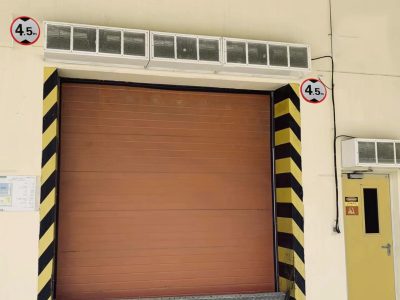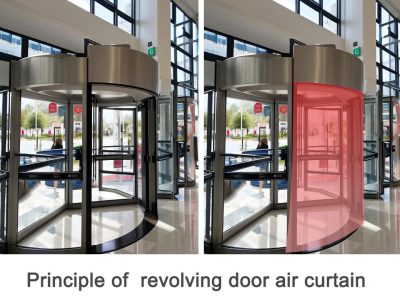1. Endüstriyel Hava Perdesi Nedir?
Endüstriyel hava perdelerinin açıklaması
Endüstriyel tesislerin girişinin üstüne veya yanına endüstriyel hava perdesi monte edilir, depolar gibi, fabrikalar, ve soğuk hava depoları. Başlıca işlevi, farklı ortamları ayıran görünmez bir hava bariyeri oluşturmaktır., Dış ve iç alanlar arasındaki hava değişimini etkili bir şekilde önleme.
Endüstriyel hava perdesi geçmişi
Hava perdesi kavramı 20. yüzyılın başlarından beri ortalıkta dolaşıyor., Çeşitli endüstrilerin artan taleplerini karşılamak için onlarca yıldır önemli ölçüde gelişiyor. Endüstriyel hava perdelerinin geçmişi, verimliliği artırmayı amaçlayan sürekli bir inovasyon yolculuğunu yansıtıyor, emniyet, Endüstriyel ortamlarda çevre kontrolü
Endüstriyel hava perdelerinin işlevi

Sıcaklık Kontrolü: İç ve dış ortamlar arasındaki ayrımı koruyarak, Endüstriyel hava perdeleri istenilen iç sıcaklığın korunmasına yardımcı olur. Bu özellikle sıkı sıcaklık düzenlemesi gerektiren tesisler için çok önemlidir., soğuk hava depoları gibi.
Enerji verimliliği: Hava perdeleri ısıtılmış veya soğutulmuş hava kaybını en aza indirir, böylece iklim kontrolü için gereken enerji azaltılır. Bu, önemli ölçüde enerji tasarrufuna ve daha düşük işletme maliyetlerine yol açar.
Kirletici Önleme: Bu cihazlar tozu önlüyor, dumanlar, böcekler, ve diğer kirleticilerin tesise girmesi, daha temiz ve güvenli bir çalışma ortamı sağlamak.
Gelişmiş Konfor: Taslakları azaltarak ve sabit bir iç sıcaklığı koruyarak, Hava perdeleri hem çalışanların hem de ziyaretçilerin konfor seviyelerini artırır.
Artırılmış Güvenlik: Trafiğin yoğun olduğu endüstriyel ortamlarda, hava perdeleri fiziksel bariyer ihtiyacını azaltarak görünürlüğü artırabilir, böylece güvenliği artırır.
Çalışma prensipleri

Endüstriyel hava perdeleri, farklı ortamlar arasında görünmez bir bariyer görevi gören yüksek hızlı bir hava akımı oluşturma prensibiyle çalışır.. Bu hava bariyeri, hava değişimini önleyerek endüstriyel tesis içinde istenen koşulların korunmasına yardımcı olur., kirleticiler, ve sıcaklıklar. İşte çalışma prensibinin ayrıntılı bir açıklaması:
2. Endüstriyel Hava Perdelerinin uygulanması
Lojistik ve Depolama

Kapı Yalıtımı: Büyük depolarda ve lojistik merkezlerinde, Hava perdeleri sıcak ve soğuk hava değişimini etkili bir şekilde önler, sabit iç sıcaklıkların korunması, özellikle sık açılan kapılarda.
Toz ve Böcek Önleme: Hava perdeleri aynı zamanda tozu da önler, böcekler, ve diğer kirleticilerin depoya girmesini önleyin, Depolanan malların temizliğini ve güvenliğini sağlamak.
Soğuk Hava Deposu ve Soğutma Tesisleri

Sıcaklık Kontrolü: Soğuk hava depoları ve soğutma tesisleri çabuk bozulan gıdaları ve diğer sıcaklığa duyarlı ürünleri saklar. Hava perdeleri düşük sıcaklıktaki ortamın korunmasına ve enerji tüketiminin azaltılmasına yardımcı olur.
Don Azaltma: Isınmayı önleyerek, nemli havanın girmesi, hava perdeleri soğuk hava deposunda don oluşumunu azaltır, böylece buz çözme sıklığını ve maliyetlerini azaltır.
Üretim Tesisleri
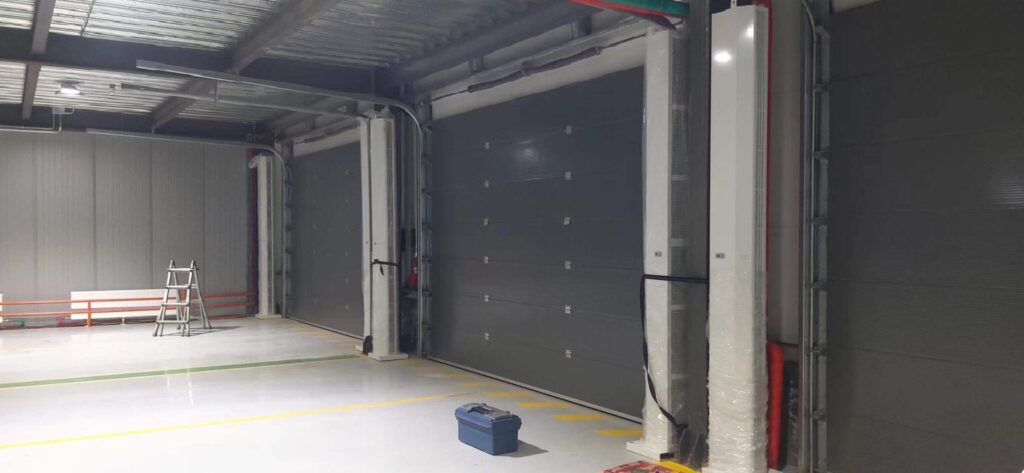
Atölye İzolasyonu: Üretim tesislerinde, farklı atölyelerin sıcaklıkları farklı olabilir, nem, veya temizlik gereksinimleri. Hava perdeleri bu atölyeleri etkili bir şekilde izole ediyor, kendi çevre koşullarını korumak.
Kirlilik Kontrolü: Hava perdeleri zararlı gazları önler, duman, veya diğer kirleticilerin diğer alanlara yayılmasının önlenmesi, Çalışan sağlığının ve üretim ortamının korunması.
Gıda İşleme Tesisleri
Hijyen Kontrolü: Gıda işleme tesislerinde, hava perdeleri böceklerin ve diğer kirletici maddelerin işleme alanlarına girmesini engeller, Hijyenik ve güvenli bir gıda işleme ortamının sağlanması.
Sıcaklık Yönetimi: İşleme alanlarında sabit sıcaklıkların korunmasına yardımcı olurlar, Dış sıcaklık dalgalanmalarının gıda kalitesini etkilemesinin önlenmesi.
Elektronik ve Hassas İmalat
Temiz Odalar: Elektronik ve hassas üretim, toz ve sıcaklık üzerinde sıkı kontrol gerektirir. Temiz oda girişlerindeki hava perdeleri etkili bir hava bariyeri sağlar, iç mekan temizliğini korumak.
Statik Önleme: Bazı hava perdeleri statik birikimi azaltacak şekilde tasarlanmıştır, hassas elektronik bileşenlerin korunması.
Kimya ve İlaç Endüstrisi
Güvenlik Koruması: Tehlikeli kimyasalların kullanıldığı alanlarda, Hava perdeleri zararlı gazların yayılmasını önler, diğer alanları ve personeli korumak.
Çevre İzolasyonu: Farklı süreç alanlarını izole ederler, Çapraz bulaşmanın önlenmesi ve üretim kalitesinin iyileştirilmesi.
Atölye Girişleri
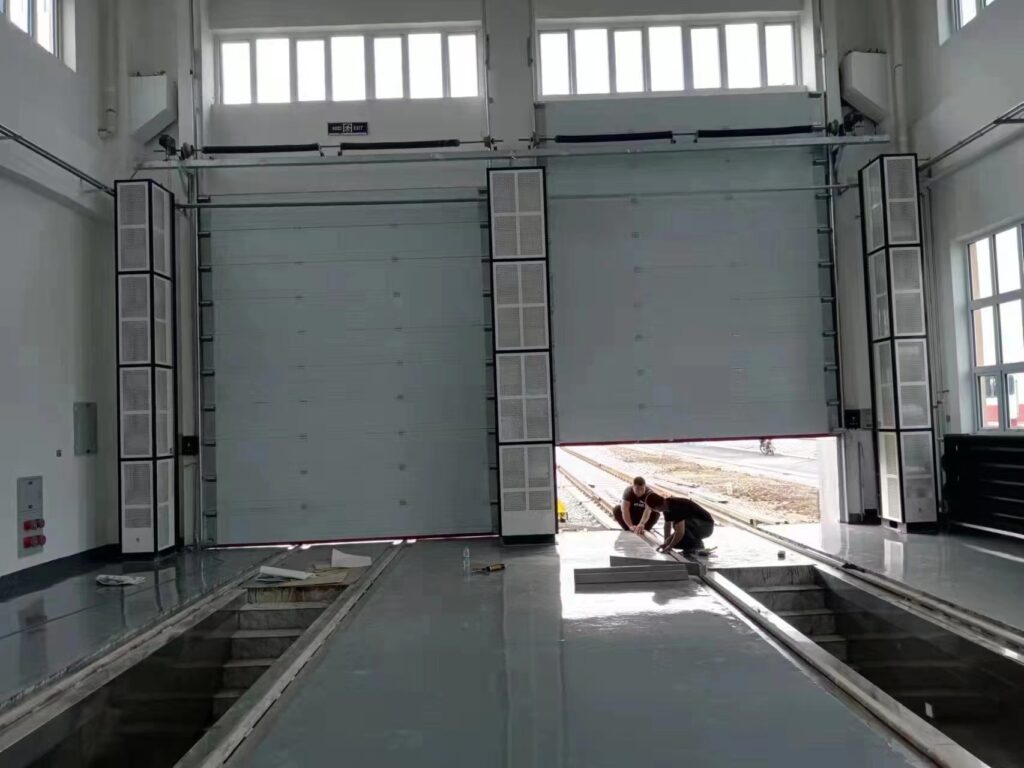
Araç Girişi: Atölye girişlerinde, özellikle yoğun araç trafiğinin olduğu yerlerde, Hava perdeleri, dış toz ve kirletici maddelerin araçlar tarafından iç mekana getirilmesini engeller, atölyeyi temiz tutmak.
3. Endüstriyel Hava Perdesi Tipleri
Hava Akış Yönüne veya Kurulum Yöntemine Göre
Yatay endüstriyel hava perdeleri en yaygın tiptir ve genellikle kapı aralıklarının veya açıklıkların üzerine monte edilir.. Açıklık boyunca aşağı doğru üfleyen yatay bir hava akımı yaratırlar, görünmez bir bariyer oluşturuyor
Dikey endüstriyel hava perdeleri kapı veya açıklıkların yanlarına monte edilir., ve giriş boyunca yatay olarak üflenen dikey bir hava akımı yaratırlar. Daha az yaygındırlar ancak yatay hava perdelerinin pratik olmayabileceği bazı uygulamalarda kullanışlıdırlar.
İşleve Göre
Standart hava perdeleri: iç ve dış ortamları ayıran bir hava bariyeri oluşturmak üzere tasarlanmıştır. Isıtma fonksiyonu olmayan bu tip hava perdesi,soğuk alanda kullanıma uygun değildir.
Isıtmalı hava perdeleri: girişe üflenmeden önce havayı ısıtan ısıtma elemanları ile donatılmıştır. Bunlar özellikle soğuk iklimlerde veya kış aylarında faydalıdır., Ek ısıtma sağlarken soğuk havanın içeri girmesini önleyerek sıcak bir iç ortamın korunmasına yardımcı olduklarından.
Soğutmalı hava perdeleri: soğuk hava perdeleri olarak da bilinir, Soğuk hava depolarında kullanılır, süpermarketler, ve düşük sıcaklığın korunmasının çok önemli olduğu diğer yerler. Sıcak havanın içeri girmesini önlemek için soğuk havayı aşağıya doğru üflerler, böylece içerideki serin ortam korunur.
4. Seçimi Endüstriyel Hava Perdeleri
Kapı Boyutuna Göre
Genişlik ve Yükseklik: Hava perdesinin takılacağı kapının veya açıklığın genişliğini ve yüksekliğini ölçün. Hava perdesi tüm genişliği kaplayacak kadar geniş olmalı ve zemine ulaşmak için yeterli hava akışını oluşturmalıdır..
Çoklu Birimler: Geniş açıklıklar için, yan yana yerleştirilmiş birden fazla hava perdesi ünitesi kullanmayı düşünün.
Kurulum Yüksekliğine Göre
Montaj Yüksekliği: Hava perdesinin monte edileceği yüksekliği belirleyin. Hava perdeleri montaj yüksekliklerine göre farklı performans özelliklerine sahiptir.
Kullanım Ortamına Göre
Çevresel Faktörler: Nem gibi faktörleri dikkate alın, toz, ve çevredeki kimyasallara maruz kalma,o zaman paslanmaz çelik endüstrisi hava perdesini kullanmayı seçebiliriz.
Hava Akış Hızı ve Hacmine Göre
Hava Hızı: Güçlü bir bariyer oluşturmak için yeterli hava akış hızına sahip bir hava perdesi seçin. Önemli basınç farklılıkları olan veya güçlü hava akımlarının mevcut olduğu alanlar için daha yüksek hızlar gerekir.
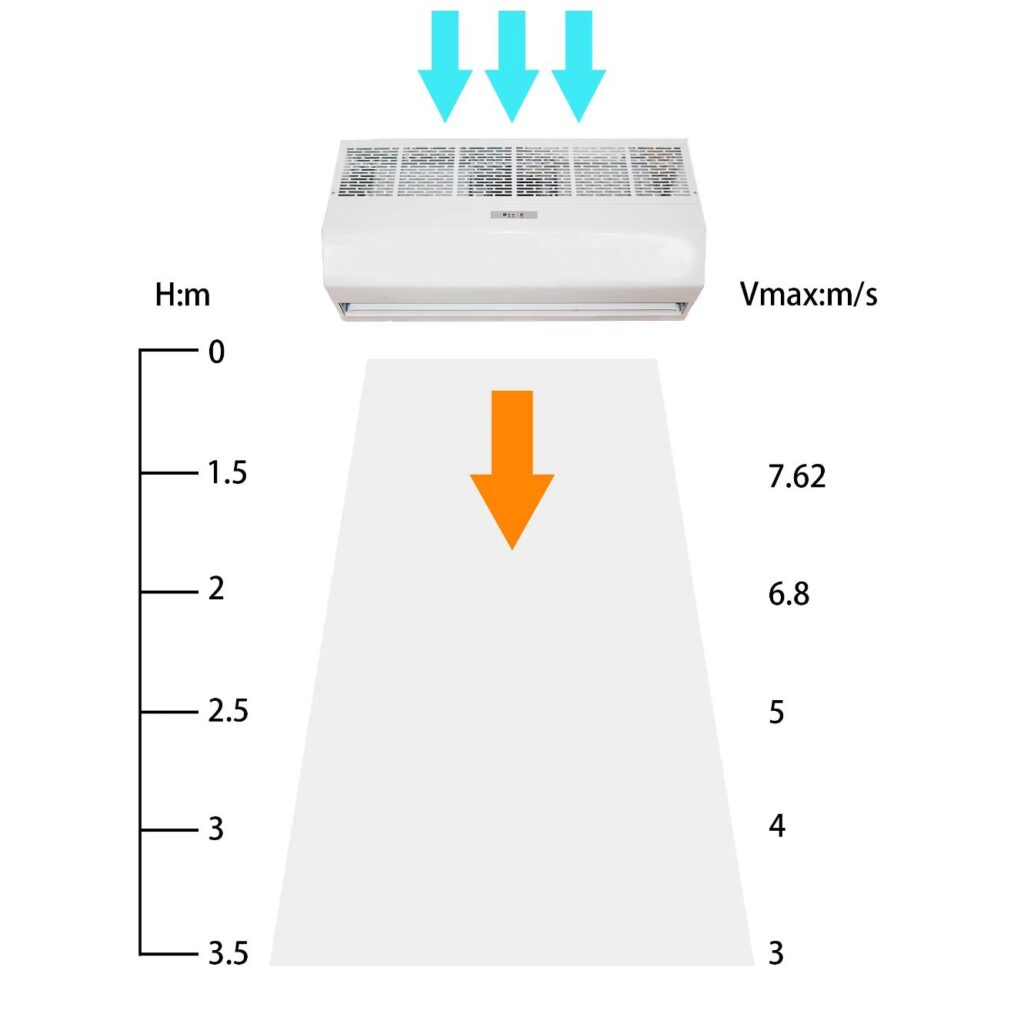
Hava Hacmi: Ünitenin kapıyı etkili bir şekilde kapatmak için yeterli miktarda havayı hareket ettirebildiğinden emin olun
Sıcaklık Kontrolü:
Standart vs. Isıtmalı vs. Soğutmalı: Standart arasında seçim yapın, ısıtmalı, veya sıcaklık kontrol ihtiyaçlarına göre soğutulmuş hava perdeleri.
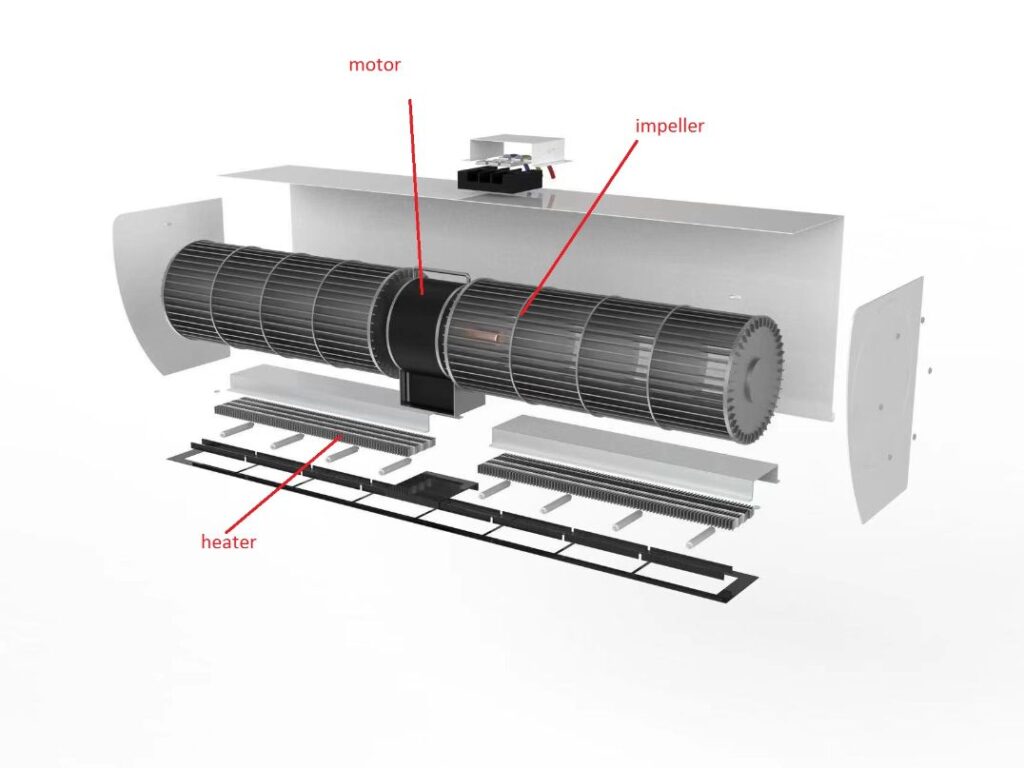
Enerji Verimliliği ve Gürültü Kontrolüne Dayalı
Operasyonel Maliyetler: Hava perdesinin enerji tüketimini ve bunun işletme maliyetlerine etkisini göz önünde bulundurun. Enerji tasarruflu modeller uzun vadeli tasarruf sağlayabilir. Enerji tasarrufu sağlamak amacıyla hava perdesi için kapı anahtarını veya kapı sensörünü seçebiliriz.
Marka ve Kalite Karşılaştırması
Garanti ve Destek: Üreticinin iyi bir garanti ve güvenilir müşteri desteği sunduğundan emin olun. CDAIRTECH kurulumdan sonra 2 yıl garanti veriyor. Ve her zaman 7*24 saat çevrimiçi destek.
5. Endüstriyel Hava Perdelerinin Montajı ve Bakımı
Kurulum Adımları
Kılavuzu Okuyun: Üreticinin kurulum kılavuzunu ve yönergelerini dikkatlice okuyun.
Bileşenleri Kontrol Edin: Tüm bileşenlerin ve aksesuarların mevcut ve iyi durumda olduğunu doğrulayın.
Araçlar ve Ekipmanlar: Gerekli tüm alet ve ekipmanları toplayın, matkaplar gibi, tornavidalar, ölçüm bandı, seviye, ve montaj braketleri.
Açıklığı Ölçün: Hava perdesinin doğru boyutta olduğundan emin olmak için kapı aralığının veya açıklığın genişliğini ve yüksekliğini ölçün.
Montaj Konumunu Belirleyin: Hava perdesinin kapının üzerine yatay olarak mı yoksa yanlara dikey olarak mı monte edileceğine karar verin, özel uygulamaya dayalı.
Montaj Noktalarını İşaretleyin: Duvar veya kapı çerçevesindeki montaj noktalarını işaretlemek için bir seviye kullanın. İşaretlerin düz ve eşit aralıklı olduğundan emin olun.
Matkap Delikleri: Montaj braketleri için işaretli noktalara delikler açın. Duvar malzemesine göre uygun matkap uçları kullanın.
Braketleri Tak: Montaj braketlerini uygun vidalar ve dübeller kullanarak duvara veya çerçeveye sabitleyin
Hava Perdesini Kaldırın: Bir asistanın yardımıyla, hava perdesi ünitesini kaldırın ve montaj braketleriyle hizalayın.
Üniteyi Sabitleyin: Hava perdesini montaj braketlerine takın ve üreticinin belirttiği cıvata veya vidaları kullanarak sabitleyin.
Hizalamayı Kontrol Et: Hava akışını eşit şekilde dağıtmak için hava perdesinin düzgün şekilde hizalandığından ve düz olduğundan emin olun.
Güç Kaynağı: Herhangi bir elektrik bağlantısı yapmadan önce güç kaynağının kapalı olduğundan emin olun.
Kablolama: Hava perdesini üreticinin bağlantı şemasına göre elektrik güç kaynağına bağlayın. Bu, kabloların bir elektrik prizine bağlanmasını veya ünitenin binanın elektrik sistemine kabloyla bağlanmasını içerebilir..
Güvenlik Uyumluluğu: Tüm elektrik bağlantılarının yerel elektrik kurallarına ve standartlarına uygun olduğundan emin olun.
Gücü Aç: Güç kaynağını açın ve doğru çalıştığından emin olmak için hava perdesini test edin.
Hava Akışı Ayarı: Etkili bir hava bariyeri oluşturmak için hava akışı yönünü ve hız ayarlarını gerektiği gibi yapın.
Çalışmayı Kontrol Edin: Kapı açılıp kapatıldığında hava perdesinin düzgün şekilde etkinleştirilip devre dışı bırakıldığını doğrulayın
Günlük Bakım ve Bakım
Düzenli Temizlik: Hava filtrelerini temizleyin, giriş ızgaraları, ve nozulları periyodik olarak boşaltın.
Rutin Denetimler: Tüm bileşenlerin rutin denetimlerini gerçekleştirin, fan kanatları dahil, motor, ve montaj donanımı.
Zamanında Onarımlar: Daha fazla hasarı önlemek için belirlenen sorunları derhal ele alın.
Profesyonel Servis: Optimum performansı sağlamak için üreticinin önerdiği şekilde profesyonel bakım planlayın.
Yaygın Sorunlar ve Sorun Giderme
Yetersiz Hava Akışı
Belirtiler:
- Zayıf hava bariyeri
- Hava zemine ulaşmıyor
- Tutarsız hava kapsamı
Olası Nedenler ve Çözümler:
- Tıkanmış Filtreler veya Giriş Izgaraları: Uygun hava akışını sağlamak için hava filtrelerini ve giriş ızgaralarını kontrol edin ve temizleyin.
- Engellenen Nozullar: Hava tahliye ağızlarındaki tıkanıklıkları inceleyin ve temizleyin.
- Fan Hızı Ayarları: Fan hızının uygulama için uygun seviyeye ayarlandığından emin olun.
- Aşınmış Fan Kanatları: Fan kanatlarında aşınma olup olmadığını kontrol edin ve gerekiyorsa değiştirin.
Aşırı Gürültü
Belirtiler:
- Yüksek sesle çalışma
- Olağandışı titreşimler veya sesler
Olası Nedenler ve Çözümler:
- Gevşek Montaj Donanımı: Tüm montaj cıvatalarını ve vidalarını inceleyin ve sıkın.
- Aşınmış Rulmanlar veya Motor Sorunları: Aşınmış yatakları veya motor sorunlarını kontrol edin ve gerekiyorsa değiştirin.
- Dengesiz Fan Kanatları: Fan kanatlarını denge açısından inceleyin ve gerekiyorsa ayarlayın veya değiştirin.
- Titreşim İzolasyonu: Gürültüyü azaltmak için ünitenin uygun titreşim yalıtımına sahip olduğundan emin olun.
Hava Perdesi Açılmıyor
Belirtiler:
- Güç yok
- Ünite kontrollere yanıt vermiyor
Olası Nedenler ve Çözümler:
- Güç Kaynağı Sorunları: Elektrik güç kaynağını kontrol edin ve ünitenin düzgün şekilde bağlandığından ve güç aldığından emin olun.
- Sigorta Atmış veya Devre Kesici Atmış: Yanmış sigortaları kontrol edin ve değiştirin veya devre kesiciyi sıfırlayın.
- Arızalı Anahtar veya Kontrol Paneli: Anahtarı veya kontrol panelini işlevsellik açısından kontrol edin ve gerekirse değiştirin.
- Kablolama Sorunları: Kablo bağlantılarında gevşek veya hasarlı kablo olup olmadığını kontrol edin ve onarın.
Azalan Verimlilik
Belirtiler:
- Artan enerji tüketimi
- Performansta azalma
Olası Nedenler ve Çözümler:
- Kirli Filtreler veya Bileşenler: Verimli çalışmayı sağlamak için filtreleri ve bileşenleri düzenli olarak temizleyin ve bakımını yapın.
- Yanlış Ayarlar: Ünitenin ayarlarının spesifik uygulama için optimize edildiğinden emin olun.
- Aşınmış veya Hasarlı Parçalar: Verimliliği yeniden sağlamak için aşınmış veya hasarlı parçaları değiştirin.
6. Market Endüstriyel Hava Perdeleri
Endüstriyel hava perdesi pazarı, enerji verimliliğine verilen önemin artmasıyla önemli bir büyüme yaşıyor, artan ticari inşaat faaliyetleri, ve iç mekan iklim kontrolünün sürdürülmesinde ve enerji maliyetlerinin azaltılmasında hava perdelerinin faydaları konusunda artan farkındalık.
Pazar Büyüklüğü ve Büyüme:
- Küresel hava perdesi pazarı yaklaşık ABD Doları değerindeydi 1.37 milyar 2023 USD'ye ulaşması bekleniyor 2.46 milyar tarafından 2029, yıllık bileşik büyüme oranıyla büyüyor 12.48% itibaren 2024 2029'a kadar (Piyasa Veri Tahmini) (Bilişsel Pazar Araştırması).
- özellikle, Hava perdesi pazarının endüstriyel segmentinin, üretim tesislerindeki yoğun kullanımı nedeniyle bu dönemde en hızlı büyümeye tanık olması bekleniyor., depolar, ve soğuk hava depoları.
Temel Sürücüler:
- Enerji verimliliği: Hava perdeleri, iklimlendirilmiş alanlardan enerji kaybını en aza indirerek ve dışarıdan hava girişini engelleyerek binanın işletme maliyetlerinin azaltılmasına yardımcı olur., önemli miktarda enerji tasarrufu sağlar.
- Yükselen İnşaat Faaliyetleri: Ticari bina inşaatlarının artması, alışveriş merkezleri, hastaneler, ve üretim tesisleri, özellikle Asya-Pasifik gibi gelişmekte olan bölgelerde, hava perdelerine olan talebi artırıyor
- Çevresel Kontrol: Hava perdeleri sıcaklık üzerinde etkili kontrol sağlar, nem, toz, ve böcekler, Gıda işleme gibi çeşitli endüstriyel uygulamalarda çok önemli olan, eczacılık, ve elektronik imalatı.
Bölgesel Analizler:
- Kuzey Amerika: Bu bölge, ticari ve endüstriyel sektörlerdeki yüksek benimseme oranları ve büyük pazar oyuncularının varlığı nedeniyle hava perdesi pazarına hakimdir..
- Asya-Pasifik: Tahmin dönemi boyunca en yüksek CAGR seviyesinde büyümesi bekleniyor, Çin ve Hindistan gibi ülkelerdeki hızlı altyapı gelişimi ve kentleşmenin etkisiyle.
- Avrupa: Sıkı enerji verimliliği düzenlemeleri ve ticari binalarda hava perdelerinin yaygın kullanımı nedeniyle önemli pazar payı
Piyasa Kısıtlamaları:
- Kurulum ve Tasarım Kalitesi: Kötü kurulum uygulamaları ve standartların altındaki tasarımlar pazarın büyümesini engelleyebilir, beklenen performansı ve enerji tasarrufunu sağlayamayabilecekleri için.
- Maliyet Kaygıları: İlk kurulum maliyetleri ve düzenli bakım ihtiyacı bazı işletmeler için engel oluşturabilir, özellikle küçük ve orta ölçekli işletmeler


